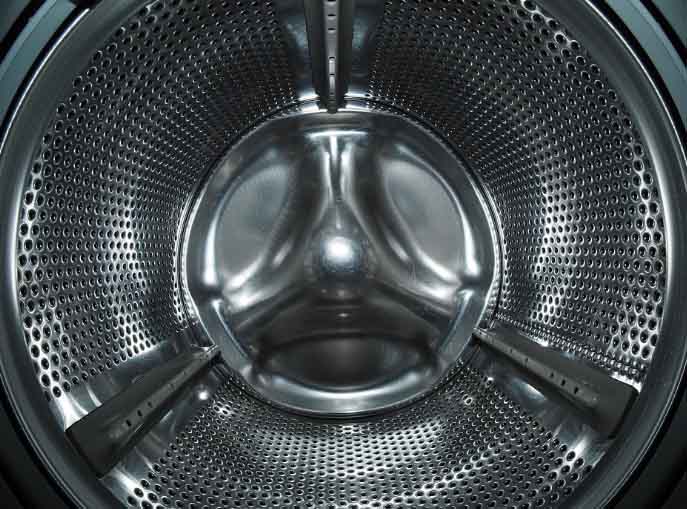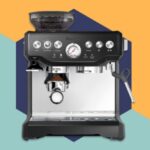The kind of drum is one thing to consider when purchasing a washing machine. They come in various sizes, but you must choose between a large and a small capacity washing machine depending on what the washing machine drum capacity entails.
Parts of the Washing Machine
Some parts will vary between your machine and the one next to it because every washing machine has a unique design and set of features. However, familiarize yourself with your washer by looking at some of the standard components it contains.
- Water pump. This rotates the machine in two directions while circulating the water. It’s employed for both draining the water during the spin cycle and recirculating it during the wash cycle.
- control valve for the water supply. This is close to the water inlet point, which automatically opens and shuts as you load the laundry depending on how much water is needed.
- Drum. You may not be aware, but washing machines actually have two tubs. The inner drum, which moves around the washing machine and has holes punched in it to let water in and out, is the one you can see where the clothes are loaded. The outer tub supports the inner drum and holds the water inside, preventing leakage into the other parts of the machine.
- Agitator or paddles. This aids in cleaning the clothes and is found inside the washing machine’s tub. While semi-automatic washing machines use an agitator that rotates inside the machine to produce a current in the machine, most fully automatic washing machines have these paddles on the rotating inner drum, which is controlled by a rotating disc. In either case, they are made to help the clothes rub against one another while washing, allowing the detergent to do its job and remove dirt and soiling from your clothes.
- washroom appliance motor. This creates a rotator motion when combined with the agitator or the disc that rotates the drum. Essentially, this is the mechanism that starts up your machine.
- Drain pipe. Your washing machine’s drain pipe allows all of the dirty water to be removed.
- PCB stands for printed circuit board. The majority of the electronics, including electrical parts and circuits, are found here and are what operate the machine. These are programmable and can assist with machine operation, serving as the washing machine’s artificial intelligence. In some cases, they even choose how long to wash or rinse for.
- Timer. Your clothes’ wash time can be set manually or automatically using this to help.
- Heating element. In the washing machine, this raises the water’s temperature to the desired level.
What is the capacity of a washing machine drum?
The net weight of dry clothes that can be washed in one cycle is used to determine a washing machine’s drum capacity. The amount of clothing you can fit into the washing machine when it is not in use is typically slightly less than this.
Typically, washing machine drum capacities range from 5 kg to approximately 12 kg, and the size you choose depends entirely on your specific requirements based on the volume of laundry, how frequently you wash it, etc.
The maximum net weight of dry clothes that can be washed in one cycle is used to determine a washing machine’s drum capacity. This is typically fewer clothes than you can fit in the washing machine when it isn’t in use. The standard range for drum capacities is 5 kg to 12 kg. And the size is completely determined by the needs based on the size of the laundry, how often it is washed, etc.
Your washing requirements and habits will determine the size of washing machine drum you need. Some people like to wash their clothes every day, while others prefer to do it only once a week. Most of the time, a medium-sized household should be able to use a drum size of 6 kg for front loading and 7 kg for top loading.
How Much Actually Gets Washed?

The type and fabric of your load will determine how much washing you can fit into the machine. For instance, you cannot wash two silk curtains, a satin bedsheet, and 12 cotton t-shirts in the majority of 6 kg washing machines. A 6 kg washing machine, however, is best suited for couples and will typically wash 30 T-shirts or one bedsheet in one wash.
Similar to how an 8 kg washing machine, which is ideal for a medium family, can easily wash 40 t-shirts and a queen-size bedsheet. It can hold more items, even bulky ones, if you cut back on the number of t-shirts. Depending on the size of the drum, the following chart can help you determine the capacity that your washing machine can handle.
Wash Drum Types
Different drum types, each with unique materials, positions, patterns, and other characteristics, can be found in washing machines.
- Plastic drums
Given their lower cost, plastic drums are more commonly found in washing machines. In both semi-automatic and fully-automatic top-loading washers, they are most frequently found. The biggest benefit of having a plastic drum is that it is simpler to clean and won’t corrode from hard water’s abrasiveness.
- Steel drums
Both top load and front load washing machines come with steel drums, which are a more expensive feature. The majority of producers use their own technology to create steel drums. It is claimed that the goal is to make sure your clothes are thoroughly cleaned during the wash and spin cycles without causing any damage.
How to Clean the Inside of the Washing Machine Drum
Start by adding 1 cup of vinegar to the liquid detergent dispenser and some to the fabric softener dispenser. Pour additional liquid until the dispenser is completely filled if it can hold more than one cup.
This will eliminate any soap residue, clean, and kill any bacteria or mold that may be growing inside.
Choose the hottest water setting, and then let the washer run through its full cycle. This will aid in removing any dirt or grime that has accumulated inside. Sanitizing settings are available on some washers. Use it now at your convenience!
Allow the drum to dry naturally by opening the door. Finally, your washing machine will be spotless and smell fresh!
Common Applications For Rotary Drum Washers
Your application determines which parts washer you should use. Automotive, aerospace, metal forming, and the ammunition industries frequently use rotary drum washers. These industries rely on effectively processing large quantities of components.
Rotary drums come in many different sizes and designs:
- Mini rotary drum washers are great for small machined parts, metal stampings and die cast components. Mini drums can also clean plastics or rubber. Mini drums from Jenfab are available in 15- and 19-inch diameters.
- Large rotary drum washers tackle high volumes of fasteners, casings, battery cans and more. Larger drums, which range in size from 30 to 45 inches in diameter, offer powerful cleaning capabilities.
- Dual drum washers offer two drums in one machine. The drum washers share the same tanks, heating systems, and dryer, but they can be run at various speeds and are made to clean various parts separately. You’ll be able to accomplish more while using up less floor space.
Fixing a Loose Washing Machine Drum
To fix a loose washing machine drum, follow these instructions. The washing machine’s top cover should first be removed. Find the washer drum, then take it out. Check for any slack in the washer’s drum. Any loose washer drums should be fixed or replaced. Examine the top-load washing machine.
Remove the Top Load from the Washing Machine
Your washing machine may suffer severe damage from a loose drum. You must first remove the top load from your appliance if you want to inspect or replace this component. Pulling on them will unlatch the top and bottom clips that are holding them in place. To release the cover from the machine, gently pull upward while pulling away from yourself to release any tension.
Locate Washer Drum & Remove Washer Drum
For thorough instructions on how to rotate your washing machine properly, head over to this page. You might have a loose drum from repeated washings or even from the drum twisting inside when it rotates.
Replace It If Necessary
It’s best to replace the washer’s drum if it still doesn’t seem to be in good shape after being tightened. As a result, you must take off the washing machine’s bottom cover. Two screws are used to secure the bottom cover. Lift the cover out of the way. Make sure the drum is in good shape before replacing it. If it is harmed, worn out, or broken, you must replace it.
Final Thoughts
Drums in washing machines frequently become unfastened. A loose washing machine drum can be fixed by tightening the nut holding it to the motor. You can turn it with a screwdriver or a wrench. You should test the machine to make sure it spins after tightening the nut. If not, change the drum.
If you have other problems with washing machines, welcome to check the following guides!
- How to Use Bleach In Your Washing Machine – Is It Safe to Use
- Can You Transport A Washing Machine On Its Side When Moving?
- How to Reset Electrolux Washing Machine With Easy Methods
- Can You Add An Agitator To A Washing Machine – How to Use
- How To Break Into Car Wash Change Machines In Simple Ways?
- How Can I Find Lost Items in the Washing Machine
- How To Install & Vent A Washing Machine Drain Pipe
- How to Reset Your Whirlpool Washing Machine? So Easy!
- How to Level a Washing Machine – Find The Perfect Level
- How to Clean a Smelly Washing Machine – Hacks & Tips
- How To Remove Mold From Rubber Seal Of Washing Machine?
- How Much Does Different Washing Machine Weigh?
- How Long Does a Washing Machine Take to Wash & Dry Clothes?
- Do Converse Shoes Well in a Washing Machine?
- How To Wash A Hat In The Washing Machine? Something You Should Know
- How to Clean Mold from a Washing Machine With Tips
- How to Level a Washing Machine? Step by Step Guide
- Can You Put Crocs In The Washing Machine? You Need Know
- How To Vent A Washing Machine Drain Pipe With Easy Steps











